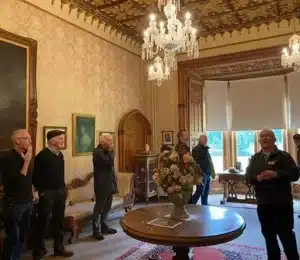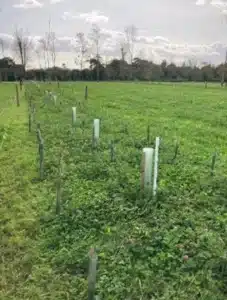Kevin O’Connell from Teagasc hosted the group of 18 members who took a day out of their schedule to learn more about the potential of agroforestry. The trip started with a tour of the castle itself, where we learned about its history whilst in private ownership, as an agricultural college, as the National Soils Laboratory and now as an important Teagasc research facility.


This plot was former ash woodland, and a few healthy specimens were left when clearance occurred, but these have since got dieback. A concern with this approach is that the trees would need ongoing shaping to grow tall and straight. Also, the fact that the cactus guards cost 17 euro each worked against this approach.
We then visited a plot where trees were planted in North-south alleyways. Each alleyway consisted of a row of three trees, with the expectation that the shrubs planted in the outer lines acted as nursery trees to the main crop central line. This kind of approach depends on electric fencing around each alley, which needs power to be run to it. In case of a power outage, cattle could easily break in and damage the trees. This is a particular risk if the stock has been left for too long, without a lot of other grazing left. Tree guards were still needed in this arrangement to protect against rabbits. There was some discussion if this could be used with wider alleys, maximizing the quantity of main crop trees, but permanent fencing would be needed in that case.

This plot was former ash woodland, and a few healthy specimens were left when clearance occurred, but these have since got dieback. A concern with this approach is that the trees would need ongoing shaping to grow tall and straight. Also, the fact that the cactus guards cost 17 euro each worked against this approach.
We then visited a plot where trees were planted in North-south alleyways. Each alleyway consisted of a row of three trees, with the expectation that the shrubs planted in the outer lines acted as nursery trees to the main crop central line. This kind of approach depends on electric fencing around each alley, which needs power to be run to it. In case of a power outage, cattle could easily break in and damage the trees. This is a particular risk if the stock has been left for too long, without a lot of other grazing left. Tree guards were still needed in this arrangement to protect against rabbits. There was some discussion if this could be used with wider alleys, maximizing the quantity of main crop trees, but permanent fencing would be needed in that case.




